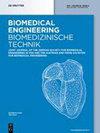Automatic sleep scoring with LSTM networks: impact of time granularity and input signals
IF 1.8
4区 医学
Q4 ENGINEERING, BIOMEDICAL
引用次数: 1
Abstract
Abstract Supervised automatic sleep scoring algorithms are usually trained using sleep stage labels manually annotated on 30 s epochs of PSG data. In this study, we investigate the impact of using shorter epochs with various PSG input signals for training and testing a Long Short Term Memory (LSTM) neural network. An LSTM model is evaluated on the provided 30 s epoch sleep stage labels from a publicly available dataset, as well as on 10 s subdivisions. Additionally, three independent scorers re-labeled a subset of the dataset on shorter time windows. The automatic sleep scoring experiments were repeated on the re-annotated subset.The highest performance is achieved on features extracted from 30 s epochs of a single channel frontal EEG. The resulting accuracy, precision and recall were of 92.22%, 67.58% and 66.00% respectively. When using a shorter epoch as input, the performance decreased by approximately 20%. Re-annotating a subset of the dataset on shorter time epochs did not improve the results and further altered the sleep stage detection performance. Our results show that our feature-based LSTM classification algorithm performs better on 30 s PSG epochs when compared to 10 s epochs used as input. Future work could be oriented to determining whether varying the epoch size improves classification outcomes for different types of classification algorithms.LSTM网络的自动睡眠评分:时间粒度和输入信号的影响
有监督的自动睡眠评分算法通常使用人工标注睡眠阶段标签的PSG数据进行训练。在这项研究中,我们研究了使用不同PSG输入信号的较短时间对长短期记忆(LSTM)神经网络的训练和测试的影响。LSTM模型在公共数据集提供的30秒epoch睡眠阶段标签以及10秒细分上进行评估。此外,三个独立的评分者在较短的时间窗口上重新标记数据集的子集。在重新标注的子集上重复自动睡眠评分实验。在单通道额叶脑电图的30 s epoch特征提取上,获得了最高的性能。准确度、精密度和召回率分别为92.22%、67.58%和66.00%。当使用较短的epoch作为输入时,性能下降了大约20%。在较短的时间点上重新标注数据集的子集并没有改善结果,反而进一步改变了睡眠阶段检测性能。结果表明,基于特征的LSTM分类算法在30秒的PSG epoch上的表现优于10秒的PSG epoch。未来的工作可能是确定不同epoch大小是否会改善不同类型分类算法的分类结果。
本文章由计算机程序翻译,如有差异,请以英文原文为准。
求助全文
约1分钟内获得全文
求助全文
来源期刊
CiteScore
3.50
自引率
5.90%
发文量
58
审稿时长
2-3 weeks
期刊介绍:
Biomedical Engineering / Biomedizinische Technik (BMT) is a high-quality forum for the exchange of knowledge in the fields of biomedical engineering, medical information technology and biotechnology/bioengineering. As an established journal with a tradition of more than 60 years, BMT addresses engineers, natural scientists, and clinicians working in research, industry, or clinical practice.

 求助内容:
求助内容: 应助结果提醒方式:
应助结果提醒方式:


